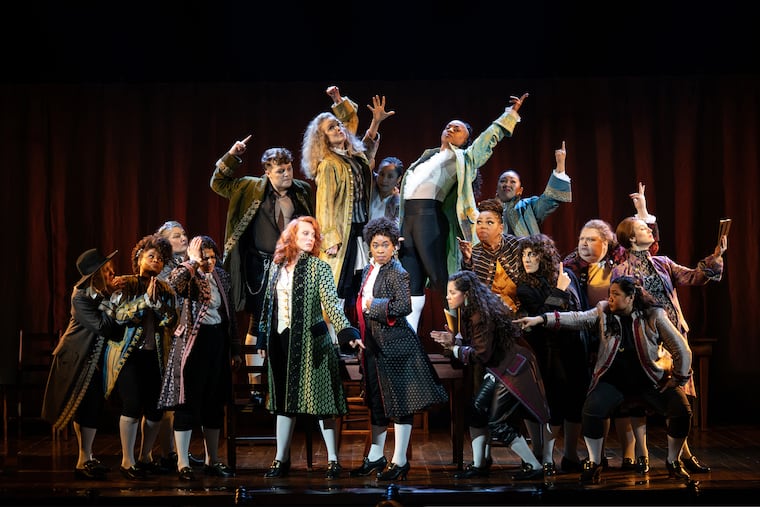When watching the gender-bending revival of ‘1776,′ keep an eye out for the coats. They’re one of a kind.
“These coats were not designed for all genders,” said costume designer Emilio Sosa. So he shook things up.

The buzzy revival of 1776, now running at the Forrest Theatre, presents a unique challenge in its wardrobe. Where the original musical cast white men in the roles of the Founding Fathers, the new, diverse production has cast women and transgender and nonbinary actors in their place. That means a total costume revamp, starting with the era’s signature colonial coats.
“These coats were not designed for all genders,” said costume designer Emilio Sosa, a Broadway mainstay. “It’s a period-based show, but I took a lot of creative leeway in the fits.” Sosa wanted to infuse the actors’ personalities into their characters’ coats. “It’s such an important story, not only about the founding of a nation … it was also an erasure of a segment of society. To have most of that segment of society tell the story [now] gives it another layer,” he said.
The revival’s gender-bent approach is full of pointed messages as the show asks audiences to see the duality of historical figures — John Adams, Benjamin Franklin, Thomas Jefferson — and the multicultural group of actors — Gisela Adisa, Liz Mikel, and Nancy Anderson, respectively — stepping into the founders’ buckle shoes. That transition is explicit in the opening moments: The actors first appear in modern clothing that reflects their off-stage identities before they don their special coats and begin debating American independence.
Jefferson, known for his bold fashion choices, boasts a purple and gold velvet coat with a fleur-de-lis brocade that emphasizes his Francophile character. Franklin wears green velvet, which Sosa describes as pragmatic and earthy. Adams is more muted in color, which Sosa uses to symbolize his restraint, but still shows off some wealth in the use of silver buttons. And a red lining that, as Sosa said, “is a shock amongst the black and white of that costume, [illustrating] the inner fire of his spirit.”
The coats are so customized for each actor that even understudies have their own. “You’re playing the same role, but you’re a different person. I can’t put someone else’s energy on you through the costume,” said Sosa. “That’s a very unique approach for us in theater.”
Sosa invited actors to collaborate on their costumes because he believed it was essential to incorporate the person into the design. He and his team put together mood boards showing photos from the actors’ Instagram accounts next to fabric swatches, colonial garb designs, and historical images of the characters. Then they worked with the actors to add their personal flair.
“It was really important to me to take up space on stage as a trans person,” said Sav Souza, who performed in local and regional theater around Philadelphia before joining 1776 to play Dr. Josiah Bartlett. Souza feels deeply connected to Philly; in 2019, they hosted a fund-raiser for their top surgery at Franky Bradley’s in the Gayborhood. Onstage, they will be wearing a sheer shirt that displays their chest scars.
“The erasure of trans people is a part of the conversation around colonialism, and the fact that I have the opportunity to stand on stage and say the words of the Founding Fathers as a trans person — as someone who is still under attack legislatively in this country today — feels really significant to me,” they said.
For Souza’s coat, Sosa used a green-yellow okra color and pewter-gold trim. “It looks really regal and strong, and that’s what I wanted to portray because [Bartlett isn’t] shy about their opinions.”
In a departure from the original script, directors Diane Paulus and Jeffrey L. Page begin the show with a land acknowledgment recognizing the Indigenous communities whose homelands were stolen, a somber nod to the violent reality that led the story of 1776 to exist. There’s a sartorial element as well: Actor Brooke Simpson wears jewelry representing her family and the Haliwa-Saponi Tribe of North Carolina.
Simpson, who played Roger Sherman on Broadway and plays the Courier on tour, said the beaded medallion necklace was made by her cousin and has been in her family for over 30 years. “The earrings that I wear are earrings that I danced in as a little girl at our powwows,” she said. She wore her family’s jewelry when she played Sherman, and the tour production made a slight change to ensure that she could still wear it in her new role.
As the unnamed Courier, Simpson symbolizes the public. Her tattered brown costume starkly contrasts with the ornate and flashy coats worn by the delegates, but her accessories stand out.
“It feels so full circle to have [the medallion] go from Hollister, N.C., on our tribal grounds, on my dad as he’s doing the grass dance or the rain dance to a Broadway stage,” said Simpson. “A piece of art from our little tribe that I don’t think we would have ever expected to have that kind of light shed on it, it just feels super special for representation.”
‘1776′ runs Feb. 14-26 at the Forrest Theatre, Kimmel Cultural Campus, 1114 Walnut St., Phila., 800-447-7400 or forrest-theatre.com.